Spatial and Temporal Variability of Extreme Precipitation Events in the Southeastern United States
Abstract
:1. Introduction
2. Methods
2.1. Study Area
2.2. Definition of 1IPH and Data Collection
2.3. Statistical Analysis
2.3.1. Trends in 1IPH Rainfall Events
2.3.2. Detection of Potential Change Points
2.3.3. Time between Events
2.3.4. Climatic Attribution
3. Results and Discussion
3.1. Trends in 1IPH Rainfall Counts
3.2. Change Points in Trends
3.3. Time between Events
3.4. Climatic Attribution
4. Conclusions
- In the last 20 years, 1IPH events increased by roughly 53 percent in the SeUS. Mann–Kendall trend tests revealed that 21/61 stations recorded a statistically significant increasing trend. Mississippi and Louisiana were the states that had the most stations with significant increasing trends in 1IPH.
- While most of the states recorded a peak of 1IPH events in JJA, Florida, Louisiana, and Mississippi recorded peaks that are wider and continued beyond JJA. JJA is the peak time for 1IPH events, but 1IPH events are not only limited to JJA, which is very true for the Gulf of Mexico bordering states.
- Pettit tests were used to detect the presence of significant change points in the 1IPH time series. Results demonstrated that 15/61 stations recorded a significant change point in their 1IPH time series. Most of the stations had a change point before the 1990′s. Three stations out of 15 stations recorded significant decreasing trends, while one station recorded a significant increasing trend before the change point. After the change point, six stations recorded a significant increasing trend, most of which are located close to the Gulf of Mexico coast.
- For the time between events, 17/61 stations recorded a significant decreasing trend, which implies that 1IPH events are happening more often and closer together in time. A total of 15/61 stations recorded the presence of a significant change point in time between events. One station out of 15 stations recorded a significant increasing trend before the change point time, while nine stations out of 15 stations recorded a significant decreasing trend after the change point. These stations are either coastal or in Florida.
- Four teleconnection indices (AMO, PDO, NAO, SOI) used in this research had positive relationships with 1 IPH events. Of these, AMO played the most significant role in changes and variability of 1IPH events in the SeUS.
- Tropical cyclone activity was thought to be an influential factor in changes and variability of SeUS precipitation. Seven percent of the 1IPH events overlapped with tropical cyclones.
- Although teleconnections are positively correlated with 1IPH at some stations, these climatic influences and natural climatic variability cannot account for the statistically significant increases in extreme precipitation found in our research and in numerous published articles in the SeUS and other regions. Climate change is the most plausible explanation. The phases of certain teleconnections that favor increased extreme precipitation can be exacerbated by climate change to enhance the odds of seeing more frequent extreme precipitation events.
Author Contributions
Funding
Data Availability Statement
Conflicts of Interest
References
- Groisman, P.Y.; Knight, R.W.; Easterling, D.R.; Karl, T.R.; Hegerl, G.C. Trends in intense precipitation in the climate record. J. Clim. 2005, 18, 1326–1350. [Google Scholar] [CrossRef]
- Powell, E.J.; Keim, B.D. Trends in daily temperature and precipitation extremes for the southeastern United States: 1948–2012. J. Clim. 2015, 28, 1592–1612. [Google Scholar] [CrossRef]
- Li, C.; Wang, R.H. Recent changes of precipitation in Gansu, Northwest China: An index-based analysis. Theor. Appl. Climatol. 2017, 129, 397–412. [Google Scholar] [CrossRef]
- Li, C.; Zhang, H.; Singh, V.P.; Fan, J.; Wei, X.; Yang, J.; Wei, X. Investigating variations of precipitation concentration in the transitional zone between Qinling Mountains and Loess Plateau in China: Implications for regional impacts of AO and WPSH. PLoS ONE 2020, 15, e0238709. [Google Scholar] [CrossRef] [PubMed]
- IPCC. Climate Change 2022: Impacts, Adaptation, and Vulnerability. Contribution of Working Group II to the Sixth Assessment Report of the Intergovernmental Panel on Climate Change; Pörtner, H.-O., Roberts, D.C., Tignor, M., Poloczanska, E.S., Mintenbeck, K., Alegría, A., Craig, M., Langsdorf, S., Löschke, S., Möller, V., et al., Eds.; Cambridge University Press: Cambridge, UK, 2022; in press. [Google Scholar]
- NOAA; National Centers for Environmental Information (NCEI). U.S. Billion-Dollar Weather and Climate Disasters. 2021. Available online: https://www.ncdc.noaa.gov/billions/ (accessed on 7 May 2023).
- Van der Wiel, K.; Kapnick, S.B.; van Oldenborgh, G.J.; Whan, K.; Philip, S.; Vecchi, G.A.; Singh, R.K.; Arrighi, J.; Cullen, H. Rapid attribution of the August 2016 flood-inducing extreme precipitation in south Louisiana to climate change. Hydrol. Earth Syst. Sci. 2017, 21, 897–921. [Google Scholar] [CrossRef]
- Brooks, H.E.; Stensrud, D.J. Notes and Correspondence Climatology of Heavy Rain Events in the United States from Hourly Precipitation Observations. Mon. Weather. Rev. 1999, 128, 1194–1201. [Google Scholar] [CrossRef]
- Touma, D.; Michalak, A.M.; Swain, D.L.; Diffenbaugh, N.S. Characterizing the Spatial Scales of Extreme Daily Precipitation in the United States. J. Clim. 2018, 31, 8023–8037. [Google Scholar] [CrossRef]
- O’Gorman, P.A. Precipitation extremes under climate change. Curr. Clim. Chang. Rep. 2015, 1, 49–59. [Google Scholar] [CrossRef]
- Howarth, M.E.; Thorncroft, C.D.; Bosart, L.F. Changes in extreme precipitation in the northeast United States: 1979–2014. J. Hydrometeorol. 2019, 20, 673–689. [Google Scholar] [CrossRef]
- Bartels, R.J.; Black, A.W.; Keim, B.D. Trends in precipitation days in the United States. Int. J. Climatol. 2020, 40, 1038–1048. [Google Scholar] [CrossRef]
- Skeeter, W.J.; Senkbeil, J.C.; Keellings, D.J. Spatial and temporal changes in the frequency and magnitude of intense precipitation events in the Southeastern United States. Int. J. Climatol. 2019, 39, 768–782. [Google Scholar] [CrossRef]
- Brown, V.M.; Keim, B.D.; Black, A.W. Trend analysis of multiple extreme hourly precipitation time series in the southeastern United States. J. Appl. Meteorol. Climatol. 2020, 59, 427–442. [Google Scholar] [CrossRef]
- Brown, V.M.; Keim, B.D.; Black, A.W. Climatology and trends in hourly precipitation for the Southeast United States. J. Hydrometeorol. 2019, 20, 1737–1755. [Google Scholar] [CrossRef]
- Yu, L.; Zhong, S.; Pei, L.; Bian, X.; Heilman, W.E. Contribution of large-scale circulation anomalies to changes in extreme precipitation frequency in the United States. Environ. Res. Lett. 2016, 11, 044003. [Google Scholar] [CrossRef]
- Dourte, D.R.; Fraisse, C.W.; Bartels, W.L. Exploring changes in rainfall intensity and seasonal variability in the Southeastern U.S.: Stakeholder engagement, observations, and adaptation. Clim. Risk Manag. 2015, 7, 11–19. [Google Scholar] [CrossRef]
- Vega, A.J.; Henderson, K.G. On the use of eigenvector techniques in climatological analysis. Pa. Geogr. 1996, 34, 50–73. [Google Scholar]
- Katz, R.W.; Parlange, M.B.; Tebaldi, C. Stochastic modeling of the effects of large-scale circulation on daily weather in the southeastern U.S. Clim. Chang. 2003, 60, 189–216. [Google Scholar] [CrossRef]
- Kunkel, K.E.; Easterling, D.R.; Redmond, K.; Hubbard, K. Temporal variations of extreme precipitation events in the United States: 1895–2000. Geophys. Res. Lett. 2003, 30, 1900. [Google Scholar] [CrossRef]
- Mishra, V.; Wallace, J.M.; Lettenmaier, D.P. Relationship between hourly extreme precipitation and local air temperature in the United States. Geophys. Res. Lett. 2012, 39, L16403. [Google Scholar] [CrossRef]
- Alipour, A.; Ahmadalipour, A.; Moradkhani, H. Assessing flash flood hazard and damages in the southeast United States. J. Flood Risk Manag. 2020, 13, e12605. [Google Scholar] [CrossRef]
- Knight, D.B.; Davis, R.E. Contribution of tropical cyclones to extreme rainfall events in the southeastern United States. J. Geophys. Res. Atmos. 2009, 114, D23102. [Google Scholar] [CrossRef]
- Chalise, D.R.; Aiyyer, A.; Sankarasubramanian, A. Tropical cyclones’ contribution to seasonal precipitation and streamflow over the southeastern and southcentral United States. Geophys. Res. Lett. 2021, 48, e2021GL094738. [Google Scholar] [CrossRef]
- Zhu, L.; Quiring, S.M. Exposure to precipitation from tropical cyclones has increased over the continental United States from 1948 to 2019. Commun. Earth Environ. 2022, 3, 312. [Google Scholar] [CrossRef]
- Mann, H.B. Non-Parametric Test against Trend. Econometrica 1945, 13, 245–259. [Google Scholar] [CrossRef]
- Kendall, M.G. Rank Correlation Methods, 2nd ed.; Hafner Publishing Co.: Oxford, UK, 1955. [Google Scholar]
- Villarini, G.; Smith, J.A.; Baeck, M.L.; Vitolo, R.; Stephenson, D.B.; Krajewski, W.F. On the frequency of heavy rainfall for the Midwest of the United States. J. Hydrol. 2011, 400, 103–120. [Google Scholar] [CrossRef]
- Towfiqul Islam, A.R.M.; Rahman, M.S.; Khatun, R.; Hu, Z. Spatiotemporal trends in the frequency of daily rainfall in Bangladesh during 1975–2017. Theor. Appl. Climatol. 2020, 141, 869–887. [Google Scholar] [CrossRef]
- Pettitt, A.N. A non-parametric approach to the change-point problem. J. R. Stat. Soc. 1979, 28, 126–135. [Google Scholar] [CrossRef]
- Villarini, G.; Smith, J.A.; Vecchi, G.A. Changing frequency of heavy rainfall over the central United States. J. Clim. 2013, 26, 351–357. [Google Scholar] [CrossRef]
- Bishop, D.A.; Williams, A.P.; Seager, R. Increased fall precipitation in the southeastern United States driven by higher-intensity, frontal precipitation. Geophys. Res. Lett. 2019, 46, 8300–8309. [Google Scholar] [CrossRef]
- Skeeter, W.; Senkbeil, J. Mid-Tropospheric Flow Characteristics of Intense Precipitation Events in the Southeastern USA. Int. J. Appl. Geospat. Res. 2020, 11, 10–23. [Google Scholar] [CrossRef]
- Huang, H.; Winter, J.M.; Osterberg, E.C. Mechanisms of abrupt extreme precipitation change over the northeastern United States. J. Geophys. Res. Atmos. 2018, 123, 7179–7192. [Google Scholar] [CrossRef]
- Hurrell, J.W. Decadal trends in the North Atlantic Oscillation: Regional temperatures and precipitation. Science 1995, 269, 676–679. [Google Scholar] [CrossRef] [PubMed]
- Visbeck, M.H.; Hurrell, J.W.; Polvani, L.; Cullen, H.M. The North Atlantic Oscillation: Past, present, and future. Proc. Natl. Acad. Sci. USA 2001, 98, 12876–12877. [Google Scholar] [CrossRef] [PubMed]
- Kunkel, K.E.; Easterling, D.E.; Kristovich DA, R.; Gleason, B.; Stoecker, L.; Smith, R. Meteorological causes of the secular variations in recorded extreme precipitation events for the conterminous United States. J. Hydrometeorol. 2012, 13, 1131–1141. [Google Scholar] [CrossRef]

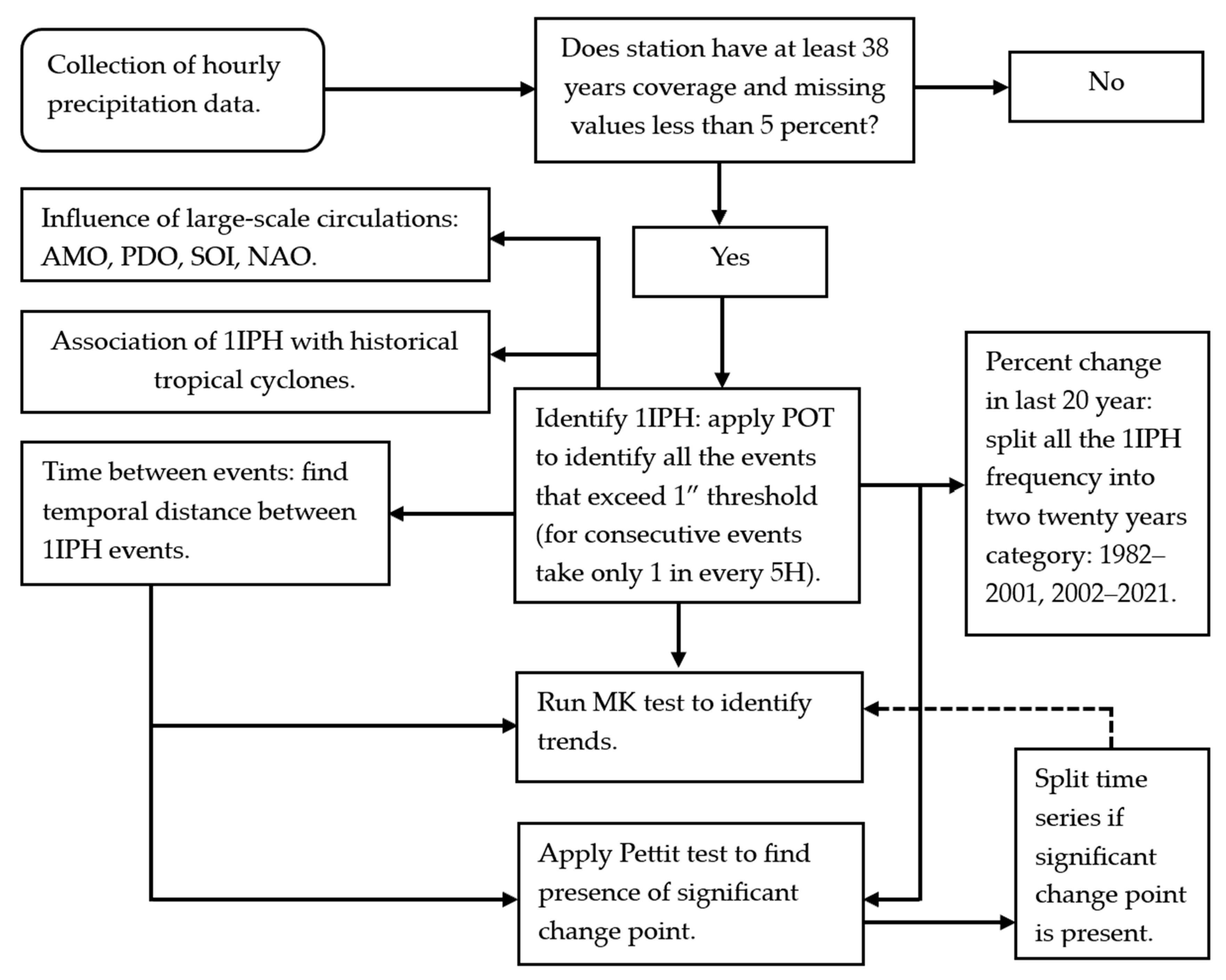
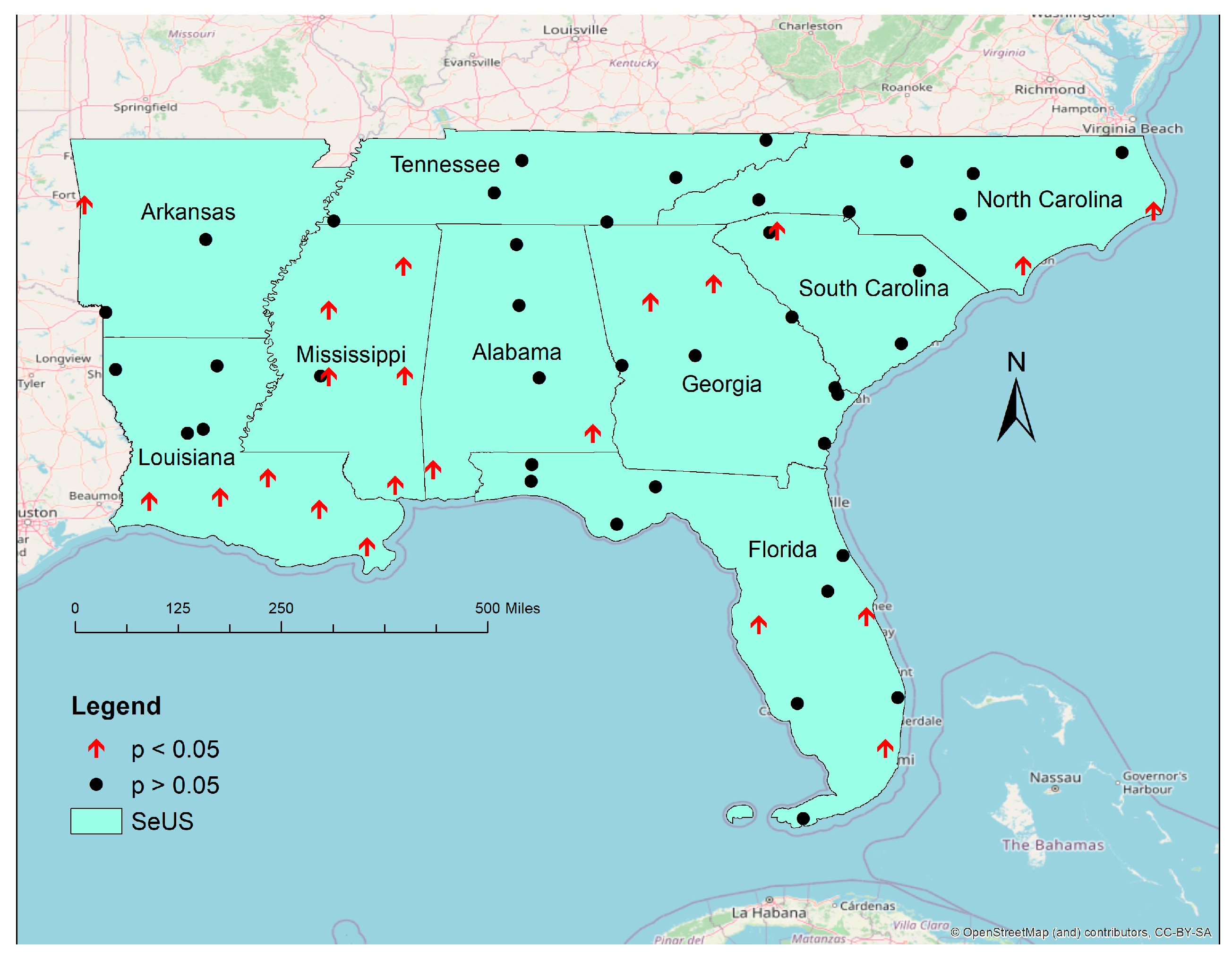


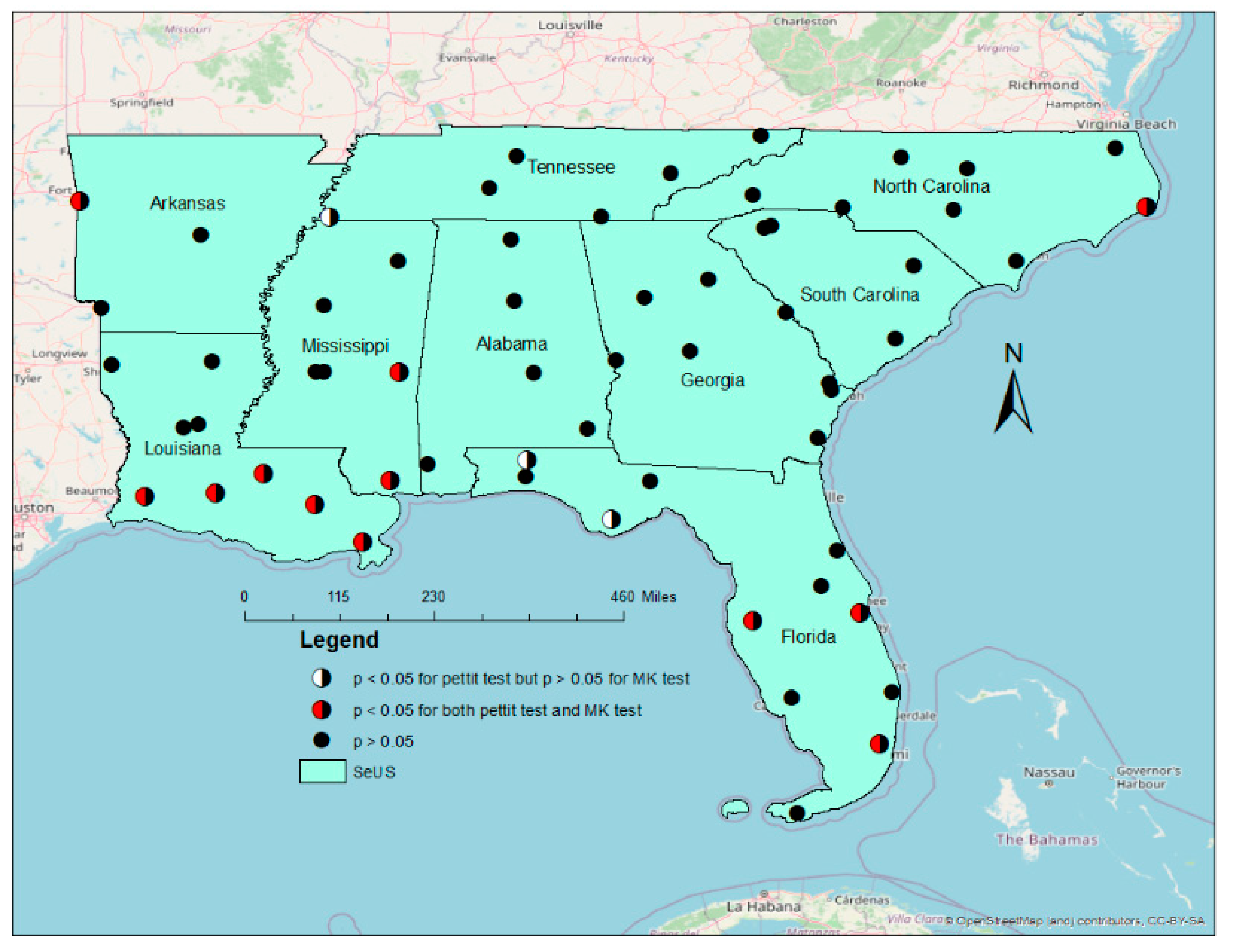
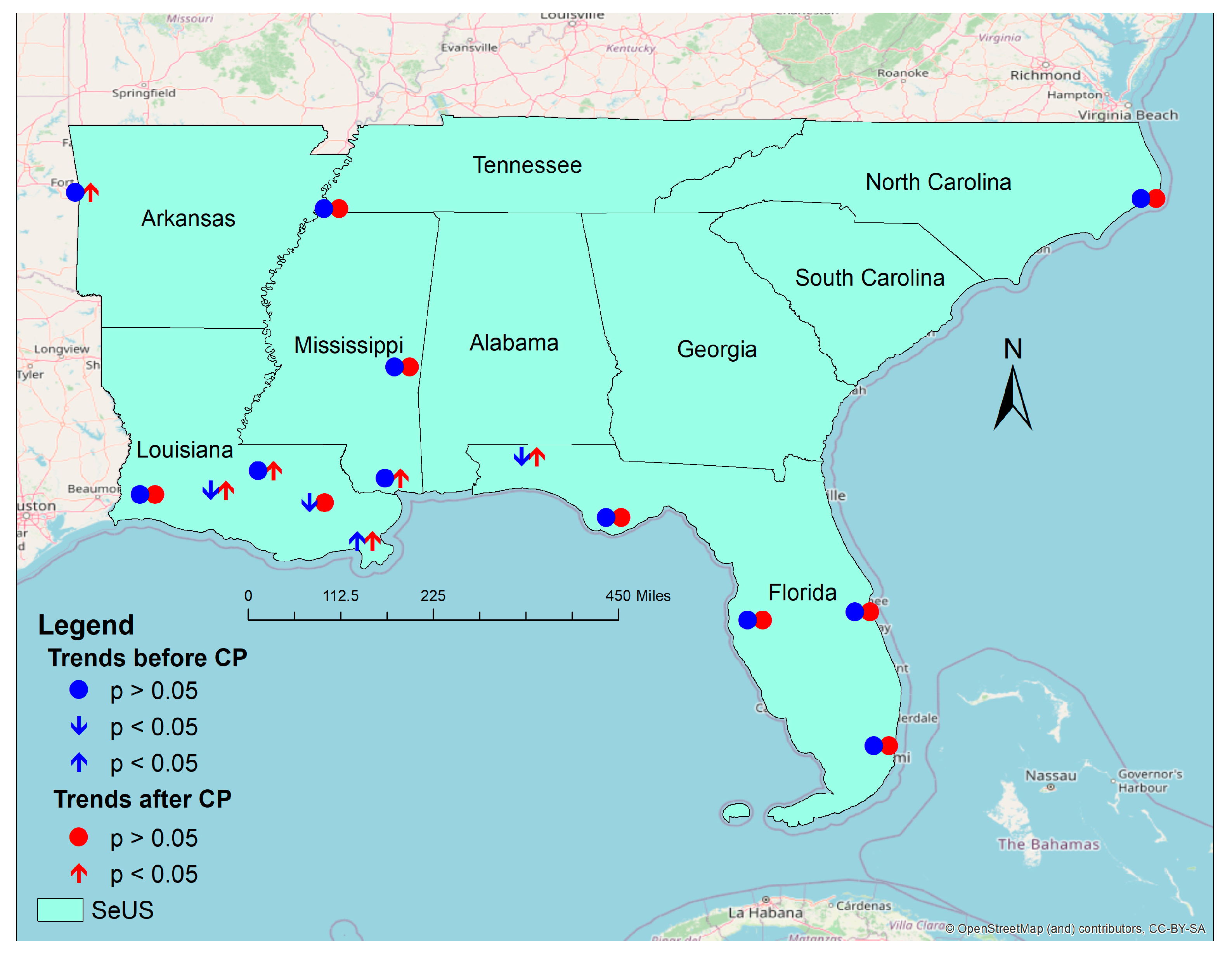

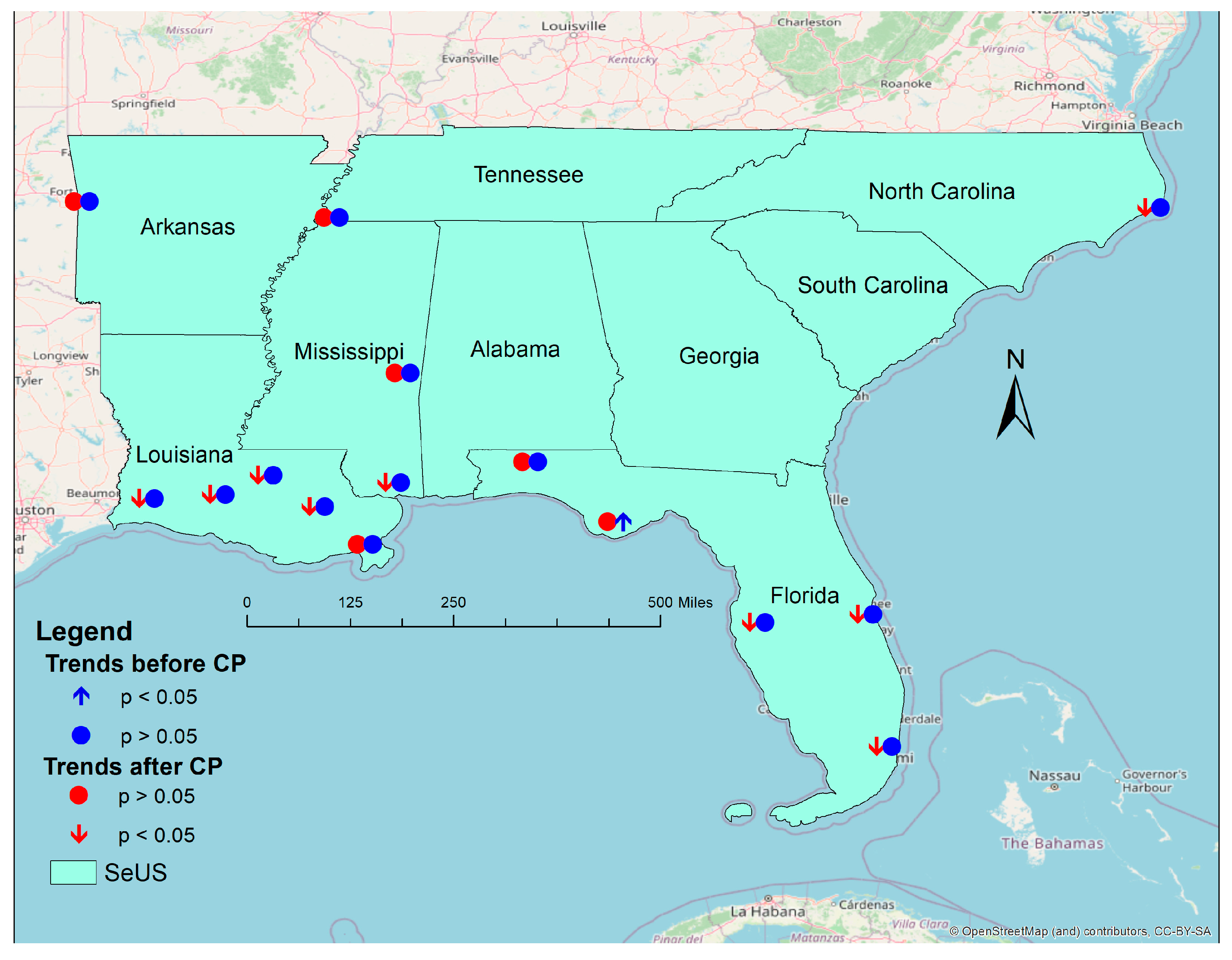
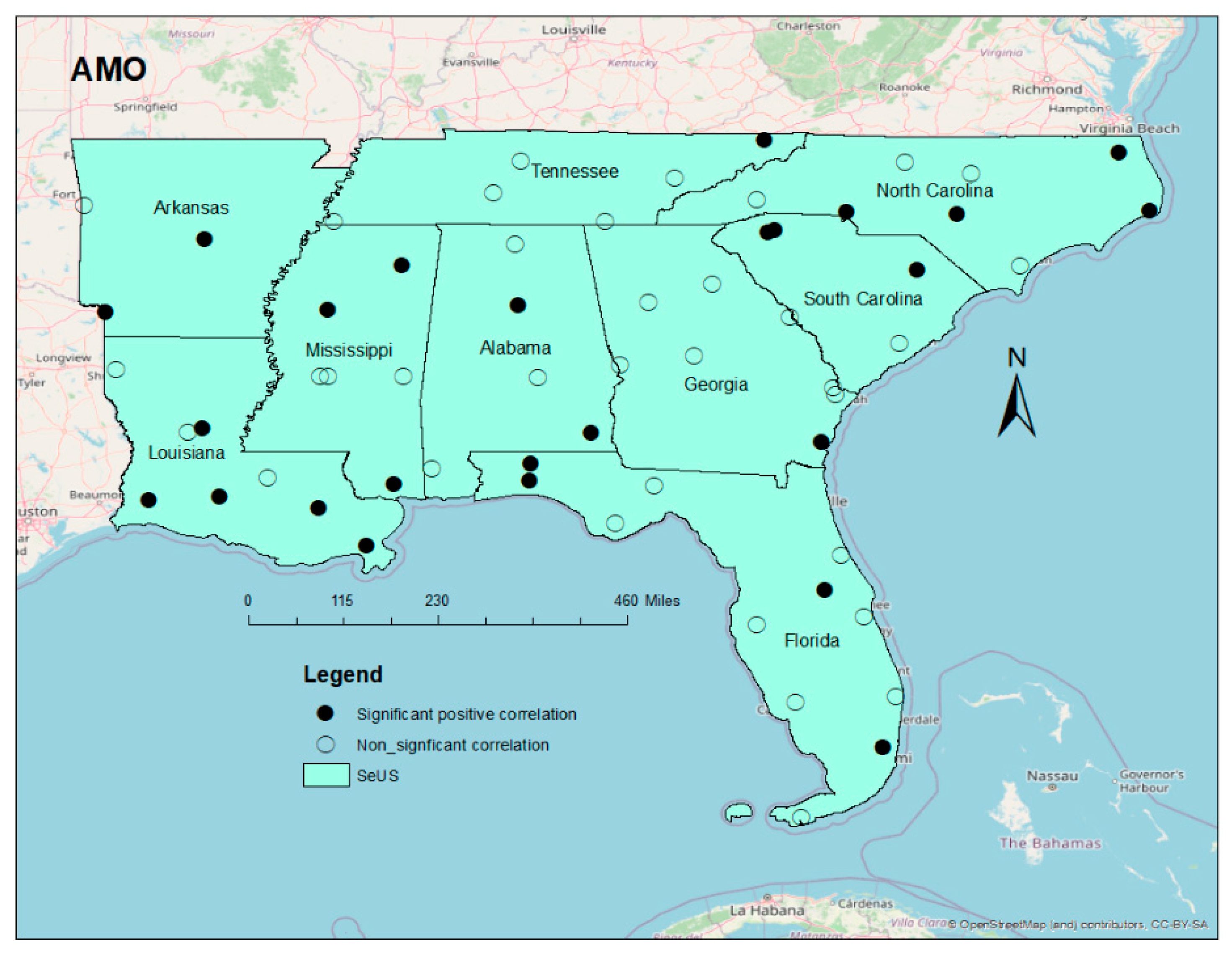
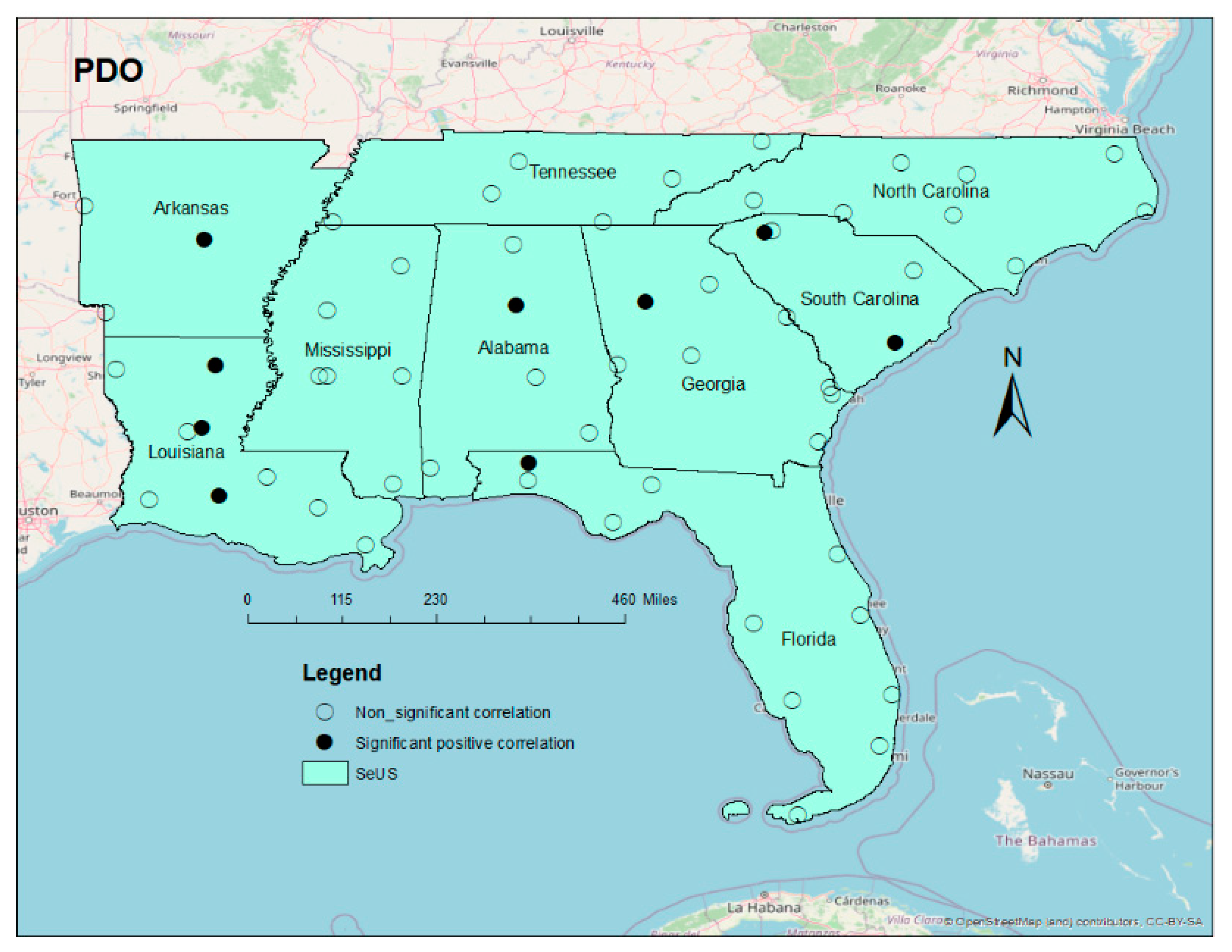
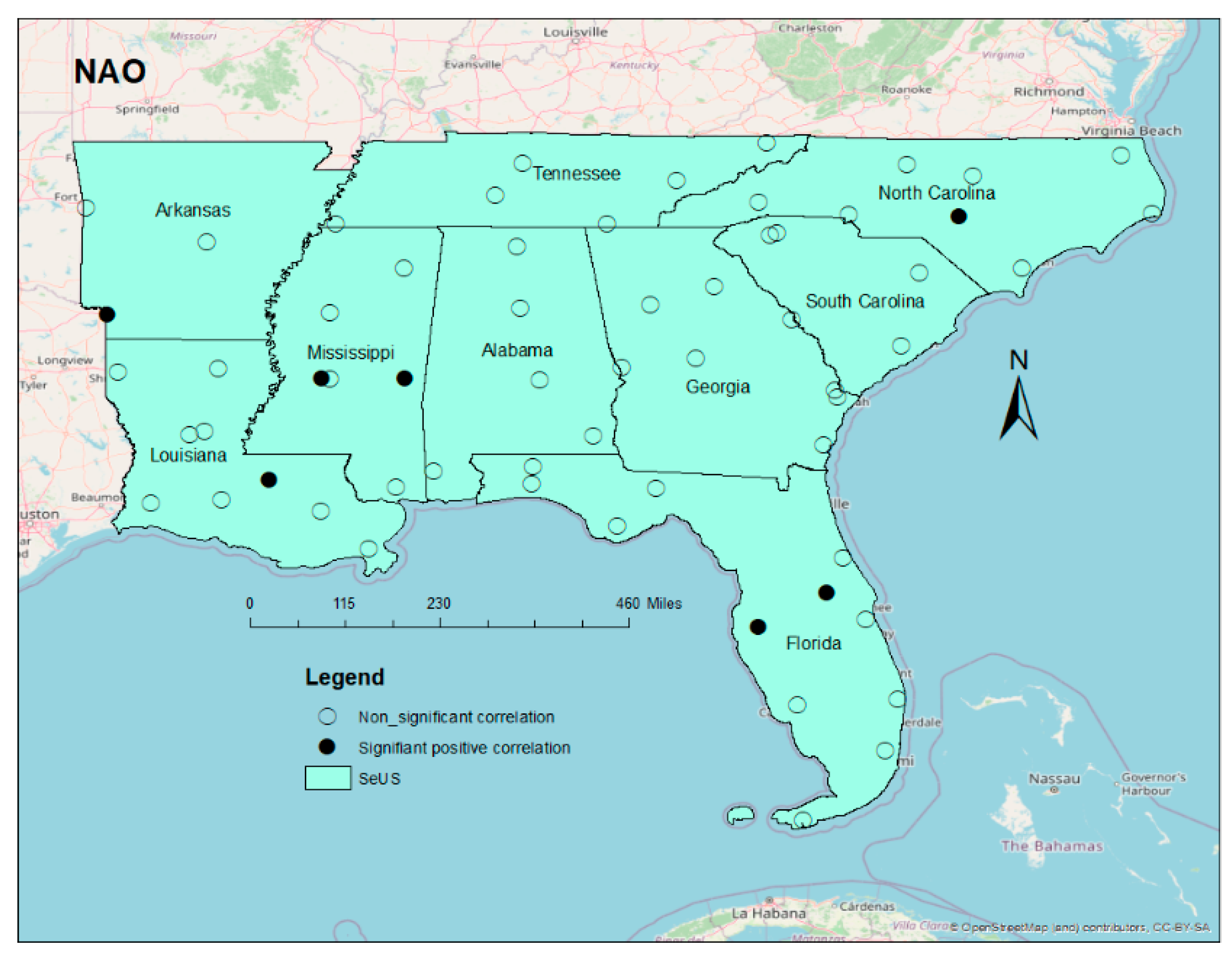
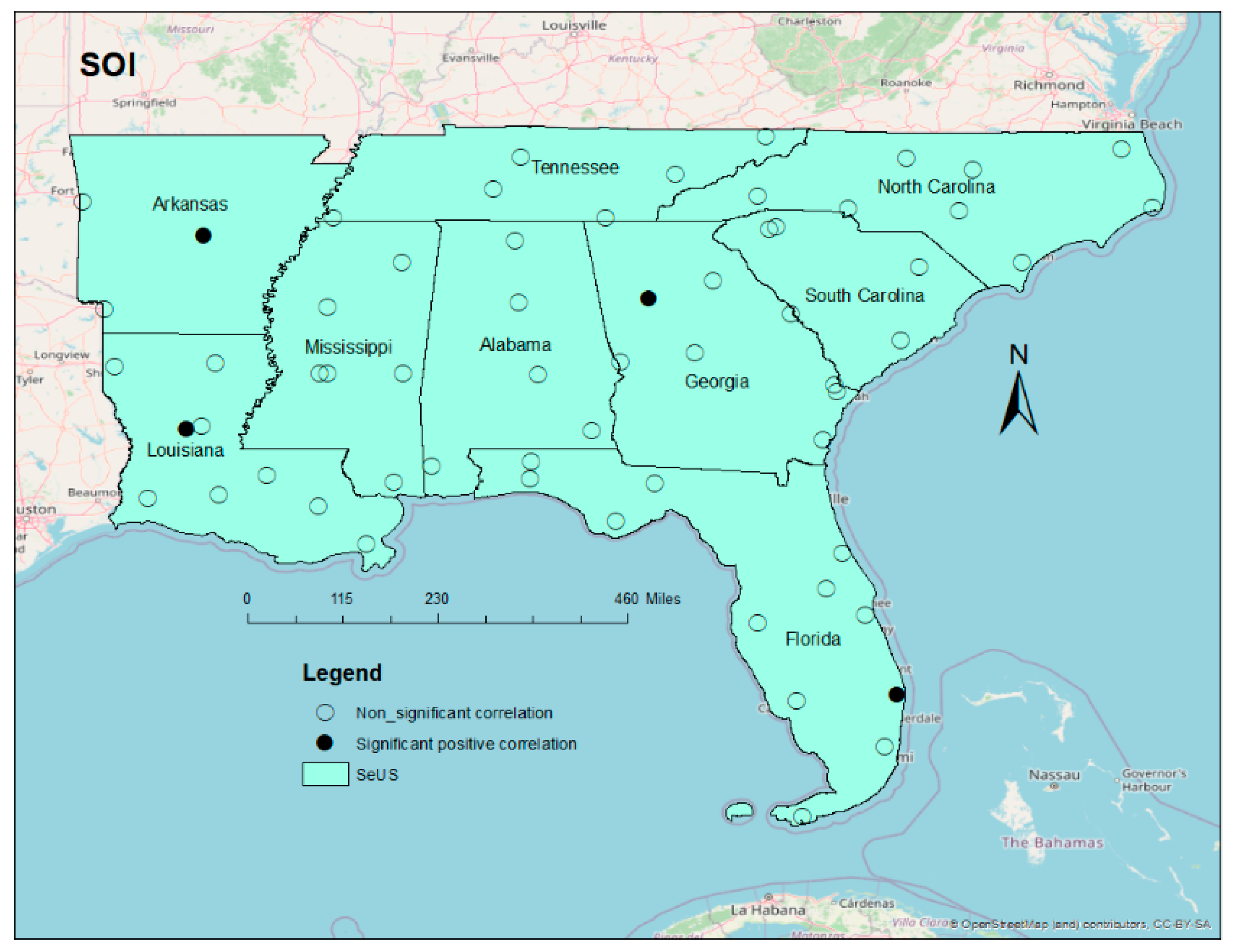
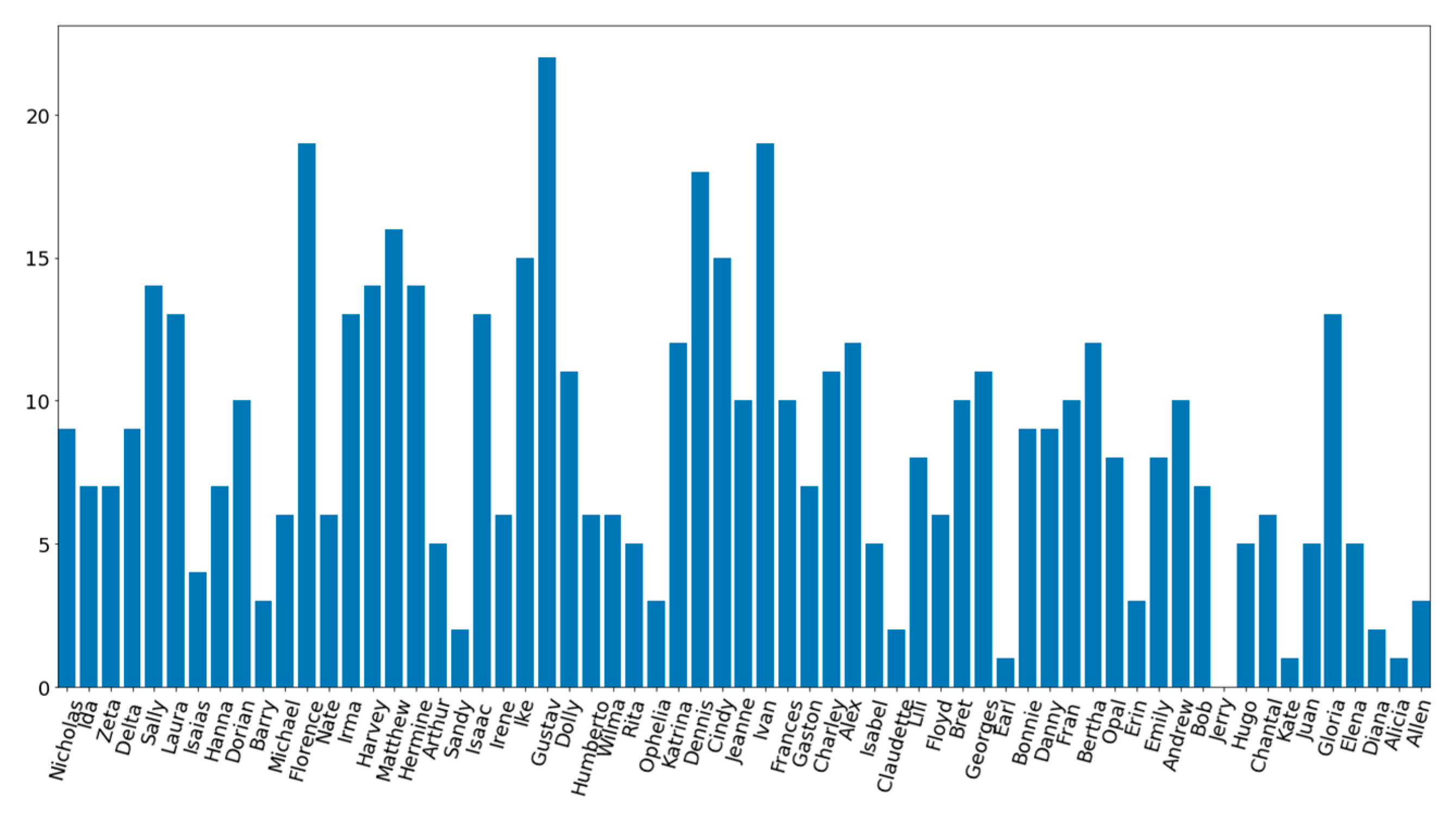
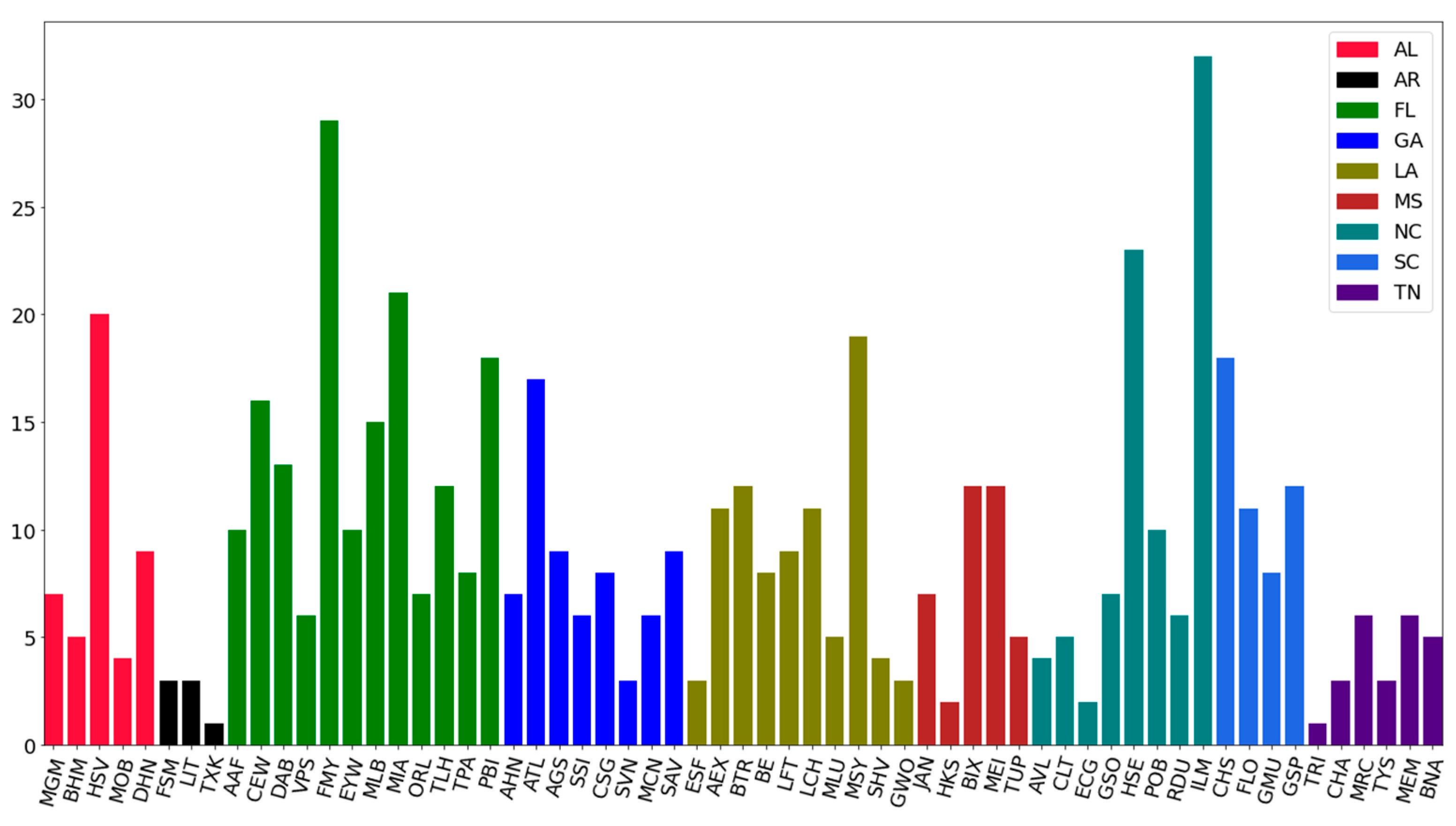
| Station | State | Start Year | Highest Hourly Rainfall | Presence of CP | Station | State | Start Year | Highest Hourly Rainfall | Presence of CP |
|---|---|---|---|---|---|---|---|---|---|
| BHM | AL | 1950 | 3.16 | No | ESF | LA | 1973 | 2.69 | No |
| DHN | AL | 1949 | 3.28 | No | LCH | LA | 1962 | 3.41 | 1987 |
| HSV | AL | 1958 | 2.33 | No | LFT | LA | 1947 | 3.35 | 1966 |
| MGM | AL | 1949 | 4.84 | No | MLU | LA | 1947 | 3.34 | No |
| MOB | AL | 1950 | 4 | No | MSY | LA | 1954 | 4.02 | 1973 |
| FSM | AR | 1948 | 2.37 | 1992 | SHV | LA | 1948 | 4.46 | No |
| LIT | AR | 1948 | 2.87 | No | BIX | MS | 1942 | 24 | 1949 |
| TXK | AR | 1948 | 2.67 | No | GWO | MS | 1949 | 1.84 | No |
| AAF | FL | 1972 | 3.77 | 1980 | HKS | MS | 1942 | 4.16 | No |
| CEW | FL | 1948 | 3.07 | 1959 | JAN | MS | 1948 | 2.78 | No |
| DAB | FL | 1948 | 3.72 | No | MEI | MS | 1948 | 3.4 | 1971 |
| EYW | FL | 1952 | 4.5 | No | TUP | MS | 1973 | 3.4 | No |
| FMY | FL | 1976 | 4.48 | No | AVL | NC | 1964 | 2.35 | No |
| MIA | FL | 1950 | 4.51 | 1984 | CLT | NC | 1948 | 2.83 | No |
| MLB | FL | 1974 | 3 | 1988 | ECG | NC | 1949 | 3.14 | No |
| ORL | FL | 1984 | 2.65 | No | GSO | NC | 1948 | 2.57 | No |
| TLH | FL | 1958 | 4.83 | No | HSE | NC | 1957 | 3.13 | 1985 |
| TPA | FL | 1948 | 3.01 | 1992 | ILM | NC | 1950 | 3.43 | No |
| PBI | FL | 1948 | 3.31 | No | POB | NC | 1948 | 24 | No |
| VPS | FL | 1947 | 2.66 | No | RDU | NC | 1948 | 2.64 | No |
| AHN | GA | 1958 | 3.08 | No | CHS | SC | 1949 | 3.89 | No |
| ATL | GA | 1948 | 3.58 | No | FLO | SC | 1949 | 2.1 | No |
| AGS | GA | 1948 | 3.14 | No | GMU | SC | 1948 | 3.46 | No |
| CSG | GA | 1948 | 4.51 | No | GSP | SC | 1962 | 3 | No |
| MCN | GA | 1958 | 3.59 | No | BNA | TN | 1948 | 2.9 | No |
| SAV | GA | 1948 | 3.71 | No | CHA | TN | 1948 | 2.47 | No |
| SSI | GA | 1948 | 6.07 | No | TRI | TN | 1948 | 2.83 | No |
| SVN | GA | 1948 | 3.01 | No | TYS | TN | 1948 | 2.78 | No |
| AEX | LA | 1959 | 3.1 | No | MEM | TN | 1948 | 2.6 | 1975 |
| BE | LA | 1965 | 4.3 | 1987 | MRC | TN | 1948 | 3.35 | No |
| BTR | LA | 1948 | 3.58 | 1977 |
Disclaimer/Publisher’s Note: The statements, opinions and data contained in all publications are solely those of the individual author(s) and contributor(s) and not of MDPI and/or the editor(s). MDPI and/or the editor(s) disclaim responsibility for any injury to people or property resulting from any ideas, methods, instructions or products referred to in the content. |
© 2023 by the authors. Licensee MDPI, Basel, Switzerland. This article is an open access article distributed under the terms and conditions of the Creative Commons Attribution (CC BY) license (https://creativecommons.org/licenses/by/4.0/).
Share and Cite
Rahman, M.S.; Senkbeil, J.C.; Keellings, D.J. Spatial and Temporal Variability of Extreme Precipitation Events in the Southeastern United States. Atmosphere 2023, 14, 1301. https://doi.org/10.3390/atmos14081301
Rahman MS, Senkbeil JC, Keellings DJ. Spatial and Temporal Variability of Extreme Precipitation Events in the Southeastern United States. Atmosphere. 2023; 14(8):1301. https://doi.org/10.3390/atmos14081301
Chicago/Turabian StyleRahman, Mohammad Siddiqur, Jason C. Senkbeil, and David J. Keellings. 2023. "Spatial and Temporal Variability of Extreme Precipitation Events in the Southeastern United States" Atmosphere 14, no. 8: 1301. https://doi.org/10.3390/atmos14081301
APA StyleRahman, M. S., Senkbeil, J. C., & Keellings, D. J. (2023). Spatial and Temporal Variability of Extreme Precipitation Events in the Southeastern United States. Atmosphere, 14(8), 1301. https://doi.org/10.3390/atmos14081301





